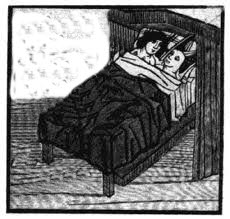“Puritanism: the haunting fear that someone, somewhere might be happy.” H.L. Mencken
When you think of New England’s Puritan founders, the word “strict” leaps to mind. Theirs was a world of unbending views with no gray zones for doubt. They had strict views on faith and worship. Strict views on family. Strict views on work ethic.
But they were strictest of all on that old bugaboo, sex.
The Puritans didn’t fool around when it came to Fooling Around. (Thumb through Hawthorne’s The Scarlet Letter to see how they dropped the hammer when someone was discovered having fun under the covers.)
So it boggles the modern mind to learn they encouraged the practice of bundling.
What is bundling, you ask? Good question. The custom is unheard of today.
 Bundling has nothing to do with those annoying Progressive Insurance commercials you see every 15 minutes on TV, where bug-eyed saleswoman Flo hawks the savings to be had by “bundling” various insurance products into one package. (A friend once summed up Flo this way: “I didn’t know Marty Feldman had a daughter.” Anyway, back to our story.)
Bundling has nothing to do with those annoying Progressive Insurance commercials you see every 15 minutes on TV, where bug-eyed saleswoman Flo hawks the savings to be had by “bundling” various insurance products into one package. (A friend once summed up Flo this way: “I didn’t know Marty Feldman had a daughter.” Anyway, back to our story.)
More than 200 years before Mick Jagger sang, “Let’s spend the night together,” Colonial America’s young people were doing it – right in front of their parents!
Bundling (also called “tarrying”) involved a young man and a young woman of marrying age spending the night together in the same bed. But because the Puritans were involved, it was more complicated than that.
 New England winters were every bit as cold then as they are now. Furniture was expensive, and bed space was at a premium. (Ever heard the old saying, “Politics makes for strange bedfellows”? Bedfellows resulted from two people, sometimes complete strangers, sharing the same bed out of necessity.)
New England winters were every bit as cold then as they are now. Furniture was expensive, and bed space was at a premium. (Ever heard the old saying, “Politics makes for strange bedfellows”? Bedfellows resulted from two people, sometimes complete strangers, sharing the same bed out of necessity.)
 There was no dating as we know it today in Colonial America. So there was very limited opportunity for prospective suitors to become acquainted with each other. Sometimes, it was as simple and direct as a man going to a woman’s father and saying, “Mr. Smith, I’d like to marry your daughter. Is that ok with you?” Even if she was agreeable, she couldn’t wed without dad’s expressly stated consent.
There was no dating as we know it today in Colonial America. So there was very limited opportunity for prospective suitors to become acquainted with each other. Sometimes, it was as simple and direct as a man going to a woman’s father and saying, “Mr. Smith, I’d like to marry your daughter. Is that ok with you?” Even if she was agreeable, she couldn’t wed without dad’s expressly stated consent.
Bundling provided a young couple the opportunity to go on a test drive, of sorts. The custom was brought over from England, and it was especially common among poorer people and in rural areas. Here’s how it worked.
The man proclaimed his interest to the girl’s parents. If he was suitable, it was then her decision whether she wanted to spend the night with him in bed. It’s important to understand the woman had the final say in this.
 If she gave the green light, the couple chatted until bedtime. Then they stripped down to their undergarments and crawled in the sack. The dad placed a large “bundling board” down the middle of the bed. It was a kind of Berlin Wall marking his side and hers, with the very clear understanding that there was to be no physical activity of any kind between them.
If she gave the green light, the couple chatted until bedtime. Then they stripped down to their undergarments and crawled in the sack. The dad placed a large “bundling board” down the middle of the bed. It was a kind of Berlin Wall marking his side and hers, with the very clear understanding that there was to be no physical activity of any kind between them.
The experience was intended to promote emotional, not physical, intimacy. The couple were expected to talk freely the entire night in a type of extended get acquainted session. If they clicked, there was a strong expectation that the man would formally propose the next day.
To make sure everything stayed on the up and up, the girl’s parents often slept in the same room.
But as you can imagine, things often didn’t turn out as virtuously as planned. Reverend Andrew Burnaby wrote unapprovingly in 1775:
“A very extraordinary method of courtship is sometimes practiced among the lower people in Massachusetts Bay Colony … if they do not agree they part, and possibly never see each other again; unless, which is an accident that seldom happens, the forsaken fair one proves pregnant, and then the man is obliged to marry her, under pain of excommunication.”
 The “forsaken fair one” may have seldom got pregnant as a result of bundling; but a respectable number of “accepted fair ones” sure did. Meaning some Colonial American women walked down the aisle carrying a different kind of bundle – and I don’t mean flowers.
The “forsaken fair one” may have seldom got pregnant as a result of bundling; but a respectable number of “accepted fair ones” sure did. Meaning some Colonial American women walked down the aisle carrying a different kind of bundle – and I don’t mean flowers.
With the Victorian Era’s arrival, bundling fell out of favor. It was ridiculed as an outdated practice perpetuated by hicks and rubes. In time, it disappeared completely.
I don’t know who the Puritan parents thought they were fooling. I never bundled in my youth, but I was once an ardent young man, and I am willing to testify under oath that no board on this planet is strong enough to keep two willing would-be lovers from touching in one form or another.
H.L. Mencken almost got it right. Puritans who practiced bundling seem to have had at least one night of happiness.
 Which explains why they spent the rest of their lives trying to make sure other people didn’t.
Which explains why they spent the rest of their lives trying to make sure other people didn’t.
Did you find this enjoyable or helpful? Please continue to join me each week, and I invite you to read Tell it Like Tupper and share your review!
Curious about Tell It Like Tupper? Here’s a chance to see for yourself. Take a sneak peek at a couple chapters in this free downloadable excerpt.


Odd. I never thought of Flo as “bug-eyed”.
She appeared that way in the early Progressive TV commercials, Mick. They de-emphasized it over time. In fairness to Flo, she doesn’t look bug-eyed in recent commercials. Guess it was my dislike to that ad campaign coming out!
you’re lucky Flo hasn’t seen this document. You’d never get bundle insurance.
Good point, Tony!